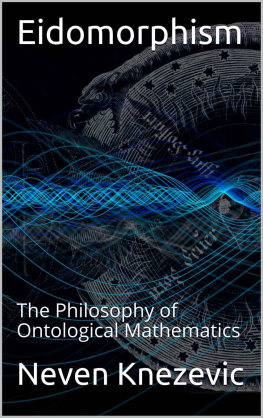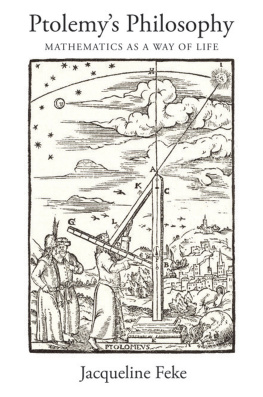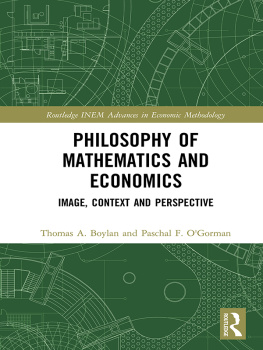Eidomorphism
The Philosophy of Ontological Mathematics
Neven Knezevic
Cover Design by:
Diarmuid Russell
www.potion.ie
Neven Knezevic 2019
www.eidomorphism.com
All rights reserved. No part of this publication may be reproduced, stored in a retrieval system or transmitted in any form or by any means, electronic, mechanical, photocopy, recording, or otherwise, without the prior permission of the author, except in the case of a reviewer, who may quote brief passages embodied in critical articles or in a review.
I dedicate this book to Irene
You are my guiding light and inspiration
Special thanks and credit goes to Jason Glowney for providing his insights on six-dimensional quantum theory; to Diarmuid Russell for his excellent design work and work ethic; and to K. Michaluk for his insights, proofreading, and editing.
Contents
1.1
2.0.1
2.0.2
2.1
3.1
3.1.1
3.1.2
3.1.3
3.1.4
3.2
3.3
3.4
3.5
4.1
4.1.1
4.1.2
4.2
4.2.1
4.3
4.3.1
4.3.2
4.3.3
4.3.4
4.4
4.4.1
4.4.2
4.4.3
4.5
4.5.1
4.6
5.1
5.1.1
5.2
5.2.1
5.2.2
5.2.3
5.2.4
5.2.5
5.2.6
5.2.7
5.3
5.3.1
5.3.2
5.3.3
5.3.4
5.3.5
5.3.6
5.3.7
5.4
6.1
6.2
6.3
6.4
6.5
6.6
6.6.1
6.7
6.8
6.8.1
6.8.2
6.8.3
6.9
6.10
7.1
7.1.1
7.1.2
7.2
7.2.1
7.2.2
7.2.3
7.3
7.4
7.4.1
7.4.2
7.4.3
7.5
7.5.1
7.5.2
7.5.3
7.6
7.6.1
7.7
7.7.1
7.7.2
7.7.3
7.7.4
7.7.5
7.8
7.8.1
7.9
7.10
7.10.1
7.10.2
7.10.3
7.11
7.11.1
7.12
7.13
7.14
8.1
8.1.1
8.1.2
8.1.3
8.1.4
8.1.5
8.2
8.2.1
8.2.2
8.2.3
8.2.4
8.2.5
8.2.6
8.2.7
8.3
8.4
9.1
9.1.1
9.1.2
9.1.3
9.1.4
9.1.5
9.1.6
9.1.7
9.1.8
9.1.9
9.1.10
9.1.11
9.1.12
9.2
9.2.1
9.2.2
9.2.3
9.2.4
9.2.5
9.3
9.3.1
9.3.2
9.3.3
9.4
10.1
10.1.1
10.2
Without mathematics we cannot penetrate deeply into philosophy.
Without philosophy we cannot penetrate deeply into mathematics.
Without both we cannot penetrate deeply into anything. G. W. Leibniz
Eritis sicit Deus, scientes bonum et malum. Mephistopheles autograph,
from Goethes Faust .
0 Apologia
My time has not yet come either; some are born posthumously. F. W. Nietzsche
Never literary attempt was more unfortunate than my Treatise on Human Nature. It fell dead-born from the press , without reaching such a distinction, as even to excite a murmur among the zealots. David Hume
Eidomorphism is an unusual title for an unusual book. Eidomorphism is both a portmanteau and a neologism of two greek words: eidos and morphe : idea and form. The term means substance as the union of form and representation. What sort of substance? Whatever it is thats just out of reach of our instruments but knowable by our existing scientific theories, knowable by inference. Why focus on such a substance? Because it holds the answers to a lot of tough questions: what did the universe come from in its earliest moments? Why is the universe intelligible? What is everything fundamentally made of? How can we know about it and why?
We all want to know something about the ultimate questions we can ask. It would be even better to find an answer. Where faith does not suffice, science must fill the gap. Where science cannot suffice, philosophy must find a way. Where philosophy fails, logic and mathematics must try even harder. That has been the way of progress, of how knowledge is made and discovered, and how we can extend our gaze beyond our eyes and instruments. Scientists and philosophers have even tried to eliminate these big questions, in hopes of finding another way towards expanding our knowledge. Predictably, these core questions arose again because we need an answer in order to find answers to other, key problems. Finding such answers is not an easy job: its one of the hardest of all.
Imagine if we did have an answer any answer. What would it look like? What form would it take? Eidomorphism is an attempt to sketch out such an answer, by going about it the long way: investigating its possibility, stating the conditions the answer must satisfy, and providing a set of criteria for this big answer. Its not in a general form, but rather as a particular answer: a single fundamental substance, with a single axiom and logic.
Eidomorphism is a term I coined to describe a curious and currently fringe theory called ontological mathematics. Ontological mathematics arose on the fringes of the internet, out of a ludibrium not unlike the Cicada 3301 phenomenon. A group of anonymous authors published dozens and dozens of books, full of materials ranging from the incredulous to the intriguing. This book summarizes the content of ontological mathematics into a single concise work, taking care to separate it from any mythological or fringe content. Many of the uncited musings are my original thoughts on the system, my extrapolations of what the system means, of what it entails. The book is a blend of original thoughts and reflections on the topic, as well as a thorough account of ontological mathematics.
Many of the books on the topic were a blend of serious philosophy, rants, musings you could entertain with friends at a bar or over a campfire, or they were more like tabloid news articles. Its a strange blend, but what caught my eye was the fact that a consistent and pretty bold idea was wedged in between everything. That idea is ontological mathematics. Having no love for nonsense often comes along with a curiosity for the incredible. Curiosity in unlikely places sometimes drives discovery.
I decided to further pursue ontological mathematics because it offered a very interesting answer to these fundamental questions. Moreover, the answer is useful, it is actionable, one can code it into a computer and run a simulation. Better yet, the philosophical reasoning behind ontological mathematics is quite persuasive and draws on many relevant debates in the history and philosophy of science. Normally, one would ignore this sort of content, but something was special about this.
Typically, in physics the drive has been towards a unified description of reality: unifying laws, unifying forces, unifying explanations. In philosophy, one should ideally have a unifying justification , and if there isnt, then at least a well-explained taxonomy of our errors along with a compendium of what we learned and good reasons why we learned what we did. What makes ontological mathematics so interesting is that it provides an alternative path between philosophy and physics. In ontological mathematics, the general form of physics remains intact, while metaphysics is allowed to do more heavy lifting. This is an interesting scenario worth looking into.
To be able to retain the general form of something while allowing for tinkering and adjustments according to abstract thinking and good argument is quite an advantage. Normally, a philosophy (such as empiricist materialism) is applied and operationalized into a set of working principles. These principles are generalized, and after enough iterations we get a working science. The other way around is to observe how science operates and draw some conclusions about it and muse on the philosophical implications. Being able to keep the general form of science and make adjustments according to a priori thinking is certainly an advantage when looking for further scientific horizons, or when seeking after more satisfying explanations.
This approach is inspiring and informative, and this book was written to document and preserve such an approach for posterity. Perhaps ontological mathematics will not be successful, and perhaps it will be: that all depends on the ability to fully develop it into a predictive science. However, the methodology of ontological mathematics the ways in which it interfaces metaphysics with natural science is worth paying attention to. It lets us direct philosophical inquiries right into the beating heart of science without losing any scientific accuracy.
Next page












